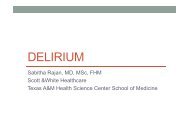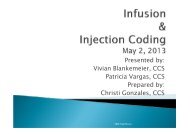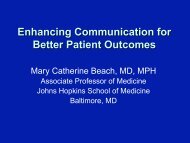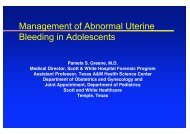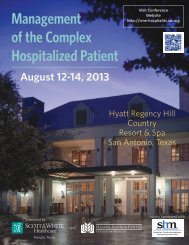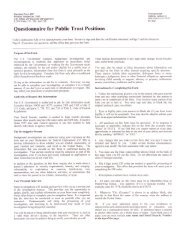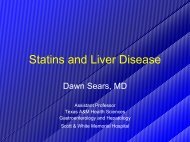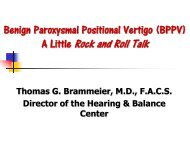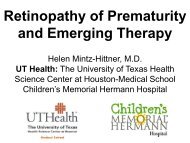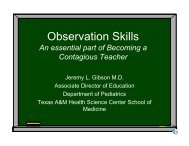Eosinophilic Esophagitis - Healthcare Professionals
Eosinophilic Esophagitis - Healthcare Professionals
Eosinophilic Esophagitis - Healthcare Professionals
Create successful ePaper yourself
Turn your PDF publications into a flip-book with our unique Google optimized e-Paper software.
<strong>Eosinophilic</strong><strong>Esophagitis</strong>Ashis Barad, M.D.Scott & WhitePediatricGastroenterology12/2/2011
fundoplications.endoscopy. and esophagus help FTT them….A long time ago in anDr. Esophageal Kellyinstitution far, far away(1995)….Wars
The Birth of EoE• All resolvedclinically andhistologically on anelemental diet• Cows milk (7), soy(4), wheat (2),peanut (2) & egg(1)
Gastrointestinal FoodHypersensitivityIgE Mediated Mixed Cell Mediated• Oral allergysyndrome• Gastrointestinalanaphylaxis• <strong>Eosinophilic</strong>esophagitis• <strong>Eosinophilic</strong>gastroenteropathy• Food Proteininduced:• enterocolitis• proctocolitis• enteropathy• Celiac Disease
Asthma of the Esophagus
Data Supporting an AllergicBasis for EoE• Most patients have associated atopy• Majority of patients have food andaeroallergen hypersensitivity as defined byskin prick test responses and/or RAST results• Evidence for T H 2-type immune response –increased levels of IL-4, IL-5 and IL-13 aswell as mast cells in the esophagus ofpatients with EoE
ndns,itiinraiet,ndroatis.toIs),isE;inionce3,p-torotinin.ereh2lsotesreceaano-dillsBa-inedhesion and promotes eotaxin-in-anism by which food antigen–elicited Th2 cell adaptiveREVIEWS INBASIC AND CLINICALGASTROENTEROLOGY
Genetics• Nearly 10% of parents of EoEcases have a history ofesophageal strictures, and~8% have biopsy-proven EoE• CCL26– encoding eotaxin-3– Only present in 14% of patients• Recent genome wideassociation study identifiedlocus at 5q22– Increased TSLP production
Conceptual Definition• <strong>Eosinophilic</strong> esophagitis represents achronic, immune/antigen-mediatedesophageal disease characterizedclinically by symptoms related toesophageal dysfunction and histologicallyby eosinophil-predominant inflammation.
Diagnostic Guideline• EoE is a clinicopathologic disease• Clinically, EoE is characterized bysymptoms related to esophagealdysfunction• Pathologically, 1 or more biopsyspecimens must show eosinophilpredominantinflammation. With fewexceptions, 15 eosinophils/hpf (peakvalue) is considered a minimum thresholdfor a diagnosis of EoE.
Diagnostic Guideline• The disease is isolated to the esophagus,and other causes of esophagealeosinophilia should be excluded,specifically PPI-responsive esophagealeosinophilia.• The disease should remit with treatmentsof dietary exclusion, topicalcorticosteroids, or both.
• In Cincinnati ( Hamilton county) EoEoccurs in approximately 1:1500(Pediatrics)• Incidence of EoE in Olmsted County,Minnesota, increased dramatically from0.35 per 100,000 during 1991–5 to 9.45per 100,000 between 2001 and 2005• Sweden 4:1000 (adults)• Pediatric studies in Western populationshave estimated an increased incidenceand prevalence to 12.8 and 43 per100,000 children, respectively
Perspective:IBD – North America• Incidence rates for range from 2.2 to 14.3cases per 100,000 person-years forulcerative colitis and from 3.1 to 14.6cases per 100,000 person-years forCrohns disease.• Prevalence ranges from 37 to 246 casesper 100,000 persons for ulcerative colitisand from 26 to 199 cases per 100,000persons for Crohns disease
Epidemiology• Incidence– EoE 12.8– IBD 2.2-14.6• Prevalence– EoE 43– IBD 26-246
EOSINOPHILIC ESOPHAGITIS IN CHILDREN 1201Childrens Hospital ofPhiladelphiaFigure 5. Graph representing Liacouras the number et of al. new Clinical EoE patients Gastro diagnosedfrom January 1 to December 31 each year for the yearsand Hep 20051994
Clinical Profile• All races and ethnic groups affected butseems to be a Caucasian predominance• Male sex predilection: 75%• Atopic manifestations (asthma, eczema,allergic rhinitis) in > 50% patients• Family history of atopy in > 45 %• Most kids are 2-6 y/o but also peak duringadolescence
Stereotypical PatientAsthmaYoung CaucasianMaleEczemaSeasonalAllergies
<strong>Eosinophilic</strong> <strong>Esophagitis</strong>: Primary presenting complaint byageN = 103Percentage of Pop.Feeding Disorder13 %Vomitting26 %Abdominal Pain26 %Dysphagia27 %Food Im paction7 %0 4 8 12 16 20Age (Years)Noel et al. NEJM 2004
GERD vs. EoE
GERD vs. EoEEoE causes GERD GERD is feeding associated causes issues esophagitis witheosinophils in the esophagusEoE causes vomitingGERD causes feeding issuesEoE causes esophagitisGERD causes vomitingEoE is associated witheosinophils in the esophagus
GERD vs. EoE• 10% of pediatric patients with GERD-likesymptoms are unresponsive to acidblockade and have EoE• 6% of pediatric patients with esophagitishave EoE
GERD vs.EoE• Recommendation to eliminate GERD whenthere is eosinophilic esophagitis– PPI dosage is 1 mg/kg per dose, twice dailyfor 8 to 12 weeks in children– Can also perform a pH probe• Repeat endoscopy after this time toassess• Hence the cutoff of 15 eos/hpf
GERD vs. EoE• 4 groups of EoE– GERD with more eosinophils than usual,has abnormal pH monitoring results anda clinicopathologic response to PPIs– PPI-responsive esophageal eosinophilia,has normal pH study results butnevertheless shows a clinicopathologicresponse to PPIs– PPI-unresponsive esophagealeosinophilia with less than 15 eos/hpf– PPI-unresponsive esophagealeosinophilia with more than 15 eos/hpf
GERD vs. EoECharacteristics EoE GERDPrevalence 1:2000 1:10Gender Male>Female Male=FemaleAtopy High NormalPolysenstization to Food Common NoFamilial Clustering Common NoProximal <strong>Esophagitis</strong> Common RarepH probe Normal AbnormalEsophageal Eosinophilia > 15 hpf Generally not very highResponse to PPI Generally no Generally yesDysphagia Common Uncommon
Who Should Undergo AnEndoscopy to Investigate for EoE?• Patients with symptoms of esophagealdysfunction or persistent upper GIsymptoms• Patients with GERD-like symptoms whohave not improved from acid suppression• Patients with a history of atopy
ilic Oesophagitis 531Diagnostic Workupabcdndoscopic photographs showing common features of eosinophilic oesophagitis. (a) Linear furrows; (b) concentric mucosal rings;apules representing eosinophilic abscesses in the oesophageal mucosa; and (d) meat bolus obstructing oesophageal lumen.
Upper Endoscopy• 33% of children with intense eosinophilicinfiltration will have a normal appearingesophagus• Biopsies must be taken!– 3 biopsies have a 97% sensitivity– 2 biopsies have a 84% sensitivity
1OLHistologyLIACOURAS ETFIG 1. Histology of the esophagus (mucosal biopsy specimens). A, Normal esophagus. B, EoE.C, EoE, superficial layering of surface eosinophils (arrow). D, EoE, microabscess (arrow).
Other Diagnostic Modalities• Upper GI contrast study to evaluate fornarrowing or stricture• CBC may reveal elevated peripheraleosinophilia but seen in only 40% ofpatients– Eosinophils may also be secondary to otheratopic diseases• pH probe study to evaluate for abnormalesophageal reflux
Allergy EvaluationNoel et al. NEJM 2004
Gastrointestinal FoodHypersensitivityIgE Mediated Mixed Cell Mediated• Oral allergysyndrome• Gastrointestinalanaphylaxis• <strong>Eosinophilic</strong>esophagitis• <strong>Eosinophilic</strong>gastroenteropathy• Food Proteininduced:• enterocolitis• proctocolitis• enteropathy• Celiac Disease
Allergy Evaluation• A thorough evaluation by an allergist orimmunologist is recommended because ofthe high rates of concurrent asthma,allergic rhinitis, eczema, and food allergy/anaphylaxis; the potential seasonality ofEoE diagnoses; and the complex interplayamong multiple allergic diatheses.• Additional testing for asthma and allergiesis recommended to improve the diagnosisand control of concurrent atopic diseases
Seasonal Variation12andloneEPIDEMIOLOGY OF EE IN OLMSTED COUNTY 1059Distribution of month of diagnosis of incident cases of EoE inOlmsted County from 1976 to 2005n int fornolated/orverentsd 13curencepectre-Figure 4. Distribution of month of diagnosis of incident cases of EE inOlmsted County from 1976 to 2005.Prasad et al. CGH 2009
e to the ongoing exposure to the triggering antigens.tibodies against IL-5 prevent the development of exrimentalEE in mice 73,74 and appeared to reduce eosinhilinfiltration of the human esophagus in early-stagenical trials 93 ; large-scale controlled trials of the effectsanti–IL-5 in patients with EE are under way. In aFuture DirectionsEE is a recently recognized and growing clinicaldisorder previously misdiagnosed as GERD, but the 2diseases are distinct in terms of their histopathology,gene expression pattern, response to therapy, hereditaryrisk, and association with allergies. Atopic disorders suchGoal Of Treatmenture 3. Regulation of the Th2 inflammatory response in EE. Food antigens induce Th2 cells to release IL-5 and IL-13, which activate eosinophilsesophageal epithelial cells, respectively. IL-13 induces epithelial cells to produce eotaxin-3 (an eosinophil chemoattractant and activating factor)down-regulate filaggrin expression. IL-5 and eotaxin-3 activate eosinophils to release MBP and EDN, which activate mast cells and dendritic
EoE Treatment• Medical– Steroids• Swallowed inhaled (fluticasone)• Swallowed (viscous budesonide)• Dietary– Elemental– Elimination• Allergy Testing Directed• Empirical Elimination Diet
Topical swallowedcorticosteroids• Fluticasone (puffed and swallowed througha metered-dose inhaler)– Adults: 440-880 mg twice daily– Children: 88-440 mg twice to 4 times daily (toa maximal adult dose)• Topical steroid inhaler without spacer• Rinse mouth after use• Nothing to eat or drink for 30 minutes afteruse
Topical swallowedcorticosteroids• Budesonide (as a viscous suspension)– Children (5 ft: 2 mg daily• Mixed with Splenda (10 packets per 1mg)• Nothing to eat or drink for 30 minutes afteruse
A Randomized double-blindplacebo-controlled trial ofFluticasone Proprianate for EoE• 31 patients: 20 treated with fluticasone880mcg/day and 11 placebo treated controlsfor 3 months• Primary endpoint: histologic with eosinophilcount < 1/hpf.• Results: 50% in treatment and 9% in placebogroup demonstrated histologic remission.• Younger age, shorter height, lighter weightand non-allergic pts were positive predictorsof response.
A Randomized double-blindplacebo-controlled trial of oralviscous Budesonide for EoE• 24 patients: 15 treated with OVB and 9placebo treated controls for 3 months• Primary endpoint: histologic with eosinophilcount < 6/hpf.• Results: 87% in treatment and 0% in placebogroup demonstrated histologic remission.• Taller patients were more likely to be partialresponders
Limitations of Topical SteroidTherapy• Long-term maintenance therapy needed to stayin remission– Most patients have symptomatic relapsewithin 9 months• Not beneficial in all patients• Unable to identify causative agent• Risk of developing oral/esophageal candidiasis
Elemental Diet• 164 children treated• Significant clinical & histological improvementin 160 (98 %)• 4/164 (2 %) no clinical or histologicalimprovement• No complications related to therapyencountered• Foods subsequently re-introduced every 5days with biopsies 4-6 weeks after the lastfood introduction.Liacouras et al Clin Gastroenterol Hepatol 2005
Elemental Diet403538.7• Pre-treatmenteosinophil count 38.7+ 10.3# of eos3025201510501.11Elemental diet1.1Pre treatDuring TreatPost treat• Post–treatmenteosinophil count 1.1+ 0.6• Most common foodsidentified: milk, egg,soy, corn, wheat andbeefLiacouras et al Clin Gastroenterol Hepatol 2005
Drawbacks to Elemental Diet• Palatability• Cost• Tubes: NGT, gastrostomy placement• Life style modification• Depression• Aversion to solids & texture relatedproblems
Elimination Diet based on SPTand/or APTEosinophil count5045403530252015105048.41.1Pre treatmentPost treatment• Average # foodallergens identified4.7 / pt• Clinical improvement:89%(131/146)• Histologicimprovement:77% (112/146)• Specific foodsidentified in 39 pts.• Most common foods:Milk, egg, soy & beefSpergel et al Ann Allergy, Asthma Immunol.2005; 95:336-343
Do Diets Based On Skin Prick• TeitelbaumTesting (SPT) Work?– All 8 children failed to demonstrate clinicalimprovement with elimination of foods that testedpositive to SPT.• Noel– All 10 children failed to respond to dietaryelimination of food antigens identified by SPT.• Gonsalves– SPT predicted only 22% of causal agentsTeitelbaum JE Gastroenterology 2002; 122:1216-1225Noel RJ Clin Gastoenterol Nutr 2004; 2: 568-575Gonsalves N Gastroenterology 2008; 134: A-104
Disadvantages• Sensitization ≠ Food allergy• False positives leading to many eliminatedfoods• EoE not completely IgE mediated, which ismechanism for skin prick testing
Atopy Patch Testing• Delayed type hypersensitivity reactions(more consistent with mechanism of EoE)• Not standardized in children• More studies involving atopic dermatitisand environmental allergies than with foodallergies
• Number of patients treated: 35• Patients were not tested for allergies• Eliminated foods: milk, soy, egg, wheat,peanuts & seafood (including shell fish)• Duration of treatment was 6 weeks• No treatment related complicationsencountered
6 Food Elimination Diet• 34/35 (97%) had significant improvementin symptoms• 26/35 (74%) histological improvement
SFED TreatmentAdd next food group if ≤ 20eos/hpf and re-biopsy 6wks laterSFEDEGDAdd egg5 foodsEliminatedEGDAdd egg+wheat4 foodsEliminatedEGDAdd egg+wheat+soy3 foodsEliminated
Food Antigens Identified viaSFED81%19%14%9%4%
Dietary Treatment Successful implementation of SFED ordirected elimination diet requires the activeparticipation of a registered dietitian Ensure balanced diet with adequatecalories Avoid the risk of food contamination
Treatment Scheme
EoE Natural History• 620 children with EoE followed over 14years– Only 10% of them developed tolerance to theirfood allergies• Food impaction is 33-50% of adults• Stricture formation in 11-33% of adults



